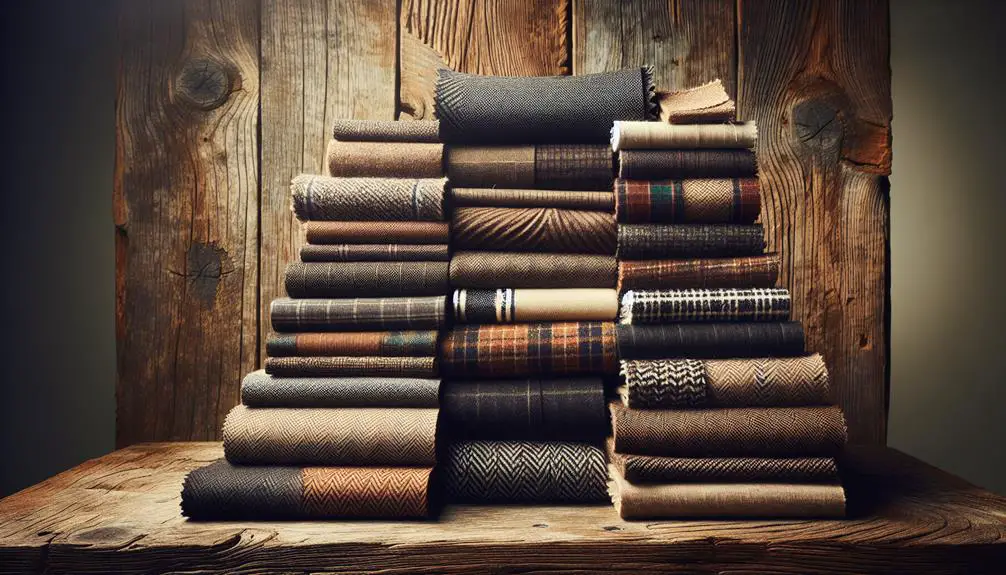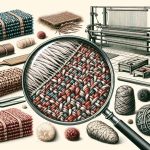I've always been curious about how long tweed can really last. It's a sturdy fabric, made from tightly woven wool, but just how much wear and tear can it withstand before it starts showing signs of age? It's not just about the material itself; factors like the weave density, the quality of the wool, and how you care for it play huge roles. I've seen some tweed jackets last decades and still look classy. So, what's the secret? Well, let's just say proper maintenance might just be key, but there's more to it than meets the eye.
Table of Contents
Key Takeaways
- Tweed durability varies with use but can last decades if properly maintained.
- High-quality wool and dense weaving enhance tweed's longevity.
- Frequent wear and improper care can significantly reduce tweed's lifespan.
- Regular cleaning and correct storage methods preserve tweed's condition.
- Early detection and repair of wear signs like fraying can extend tweed's life.
History of Tweed Fabric
Although tweed originated in Scotland in the 18th century, its durable appeal has spread worldwide. This fabric wasn't just a simple invention; it was a response to the harsh, unpredictable Scottish weather, requiring a material that could endure it while providing warmth. The name 'tweed' itself is a bit of a happy accident, stemming from a misreading or misinterpretation of the word 'twill', the weaving technique used in its making. This twist of fate didn't hinder tweed's evolution as an iconic material; instead, it bolstered its unique identity.
Tweed's cultural significance is deeply woven into its Scottish roots. Initially, it was the attire of the rural folk, synonymous with the rugged, pastoral life of the Highlands. However, its practicality soon caught the attention of the British aristocracy, who adopted it for hunting and sporting due to its resilience and discretion in the natural landscape. This shift marked tweed's progression from a utilitarian fabric to a symbol of sophisticated, outdoor leisure. Its adoption by high fashion soon followed, cementing its status as a versatile staple. Tweed isn't just fabric; it's a narrative of survival, adaptation, and elegance.
Composition and Types of Tweed
Now, let's talk about what tweed is made of and the different types you might come across.
First up, we'll look at the various materials used in tweed fibers, which play a big role in its durability and feel.
Then, we'll explore some common tweed varieties and the weaving techniques that give tweed its unique texture and pattern.
Tweed Fiber Materials
Tweed is typically made from wool, but it can also include mixes of cotton, silk, or synthetic fibers. These blends aren't just about achieving different textures or durability; they're central to tweed sustainability and innovation. By integrating various fibers, manufacturers can enhance the fabric's wearability and environmental footprint. For instance, adding synthetic fibers can improve tweed's resilience and longevity, reducing waste and the need for frequent replacements.
Moreover, these material innovations contribute to the versatility of tweed, making it suitable for everything from traditional jackets to modern, stylish wearables. It's fascinating to see how blending classic techniques with new materials can create a product that's both timeless and on the cutting edge of current fashion trends.
Common Tweed Varieties
Exploring the common varieties of tweed, we find that each type has its own unique composition and characteristics. Harris Tweed, for instance, comes strictly from Scotland's Outer Hebrides and adheres to strict guidelines regarding its handmade production. It's renowned for durability and classic patterns that reflect the rich history of its origins.
Then there's Donegal tweed, originating from Ireland, famous for its colorful speckles and rough texture. Each type of tweed has distinctive patterns that aren't just about aesthetics; they're a nod to the landscapes and history of their origins.
Understanding these differences isn't just about fashion—it's about appreciating a material's journey from local tradition to global wardrobe staple.
Tweed Weaving Techniques
Delving into how tweed is woven, we find a variety of techniques that greatly influence its texture and durability. The process starts with the type of loom used, which plays a vital role in the fabric's final appearance.
Traditional looms offer that classic, irregular look, while modern looms can produce more uniform and durable tweed. Weaving innovations have also introduced techniques like the twill weave, which interlaces warp and weft threads in a diagonal pattern, enhancing the tweed's resilience and aesthetic appeal.
Understanding these nuances is key to mastering tweed's unique qualities. Each method affects how the fabric will hold up over time, making the choice of weaving style and loom type pivotal in the creation of high-quality tweed.
Key Factors Affecting Durability
Several factors play an essential role in determining how long tweed can last. The first key thing to take into account is the fabric resilience. Tweed is known for its robustness, thanks to the tightly woven fibers which typically consist of wool. The quality of these fibers and the density of the weave directly impact how well the tweed withstands wear and tear.
Another vital aspect is care practices. How you maintain your tweed garments influences their lifespan greatly. Regular cleaning using appropriate methods can preserve the fabric's integrity, whereas harsh chemicals or incorrect washing techniques can degrade the fibers.
Here's a handy table to summarize the key factors:
| Factor | Description | Impact on Durability |
|---|---|---|
| Material Quality | High-quality wool ensures greater durability. | Direct |
| Weave Density | Denser weaves offer better protection and longevity. | Direct |
| Maintenance | Proper care practices extend lifespan. | Indirect (through wear) |
Understanding and implementing the right practices in caring for tweed can make all the difference. It's not just about avoiding damage, but actively contributing to the fabric's long-term performance. So, always check those care labels and follow the recommended guidelines to ensure your tweed stays in prime condition for years to come.
Common Uses of Tweed
Tweed is commonly used in jackets, caps, and accessories due to its durability and classic aesthetic. But let's dive deeper into how tweed fits into modern fashion trends. You see, tweed isn't just for the countryside anymore; it's been embraced by urban style mavens too. Designers are constantly innovating, blending tweed with contemporary designs to create something truly unique. This crossover has helped keep tweed relevant in the fast-paced world of fashion.
Now, let's talk about tweed accessories. They're a fantastic way to add a touch of class and texture to any outfit without going full-on tweed. Think tweed caps, bags, and even shoes. These pieces can transform a simple outfit into a statement ensemble that exudes sophistication. Additionally, these accessories are great for both men and women, proving tweed's versatility across gender lines.
Incorporating tweed into your wardrobe doesn't have to be challenging. It's all about balance. Pair a tweed blazer with a plain tee and jeans for a casual yet chic look, or go for a tweed scarf with a sleek coat for those colder months. Remember, playing with textures like tweed adds depth to your outfits, keeping you stylishly ahead.
Signs of Wear and Damage
As I've worn my tweed jacket over the years, I've noticed a few common signs of wear and damage. It's important to spot these early, whether it's fraying edges or thinning fabric, to decide if a repair will suffice or if it's time for a replacement.
I'll talk about how to identify these issues and make the right call.
Common Fabric Deterioration Signs
I've noticed that when tweed begins to age, certain signs of wear and damage, like fraying edges and thinning patches, become evident.
Fabric discoloration often shows up first, turning vibrant hues into something dull and uneven. It's not just about fading; you might see patches that have been bleached by the sun or darkened from moisture.
Stitch unraveling comes next, where the once-tight seams start giving way. This usually happens along stress points—like elbows or knees—or where the fabric rubs against itself frequently.
These signs are key indicators of the fabric's longevity and can tell you a lot about how well the tweed has been cared for or the quality of its craftsmanship initially.
Repair or Replace Decision
When you spot signs of wear like fraying or discoloration in your tweed, you're faced with the decision to either repair or replace it. It's crucial to consider the cost analysis and sustainability factors before making a choice.
| Factor | Repair | Replace |
|---|---|---|
| Cost | Generally lower | Higher initial investment |
| Environmental | Less waste, more eco-friendly | More resources used |
| Lifespan Impact | Extends current garment's life | New garment longevity |
Repairing might seem like a hassle, but it's often more sustainable and cost-effective. Ask yourself if the jacket's sentimental value or its unique style is worth keeping. If it is, stitching up a hole or fixing a fray can save you money and support environmental sustainability.
Proper Cleaning Techniques
To explore in detail, it's crucial to clean your tweed properly. Let's delve into some effective ways you can keep your tweed looking its best without causing damage.
First off, consider stain removal methods. When you spot a stain, it's tempting to go hard with soap and water, but hold up—that can actually worsen things. Instead, I gently blot the stain with a clean, damp cloth. Avoid rubbing as it can embed the stain deeper into the fabric. For oil-based stains, a bit of talcum powder before brushing it off gently works wonders.
Moving on to dry cleaning alternatives—frequent dry cleaning can be harsh on tweed. I opt for airing out my tweed garments instead. After wearing, I hang them in a well-ventilated area away from direct sunlight. This method helps in eliminating odors and minor soiling without the chemical wear-and-tear of dry cleaning.
If the tweed really needs a freshen-up, I carefully hand wash it in cold water with a mild detergent, specifically designed for delicate fabrics. Always air dry, as heat from dryers can shrink or warp the fibers.
Repairing and Restoring Tweed
After keeping your tweed clean, it's important to know how to repair and restore it to extend its life. Tweed is durable, but it can suffer from wear and tear. Let's get into the nitty-gritty of stitch reinforcement and color restoration.
Stitch reinforcement is essential. If you spot a loose thread, don't pull it! Instead, use a needle and matching thread to secure it back into place. This prevents further unraveling. For holes or tears, a darning technique with a woven pattern can integrate the repair seamlessly with the original fabric.
Color restoration can be a bit more complex. Fading colors on your tweed can be revived depending on the fabric's composition and the dyes used. I usually test a small, inconspicuous area with a color-safe dye to make sure it doesn't affect the fabric's integrity.
Here's a quick guide:
| Repair Type | Tools Needed | Tips |
|---|---|---|
| Stitch Reinforcement | Needle, Thread | Match the thread color closely to the original. |
| Darning Holes | Darning Needle, Wool | Use a loom if available for larger repairs. |
| Color Restoration | Color-safe Dye, Brush | Test on a small area first. |
| Snag Repair | Snag Needle, Patience | Gently work the snag back into place. |
| General Maintenance | Tweed Brush, Mild Detergent | Regular brushing helps maintain texture. |
Always handle repairs gently and consult a professional for major restorations. This way, your tweed remains timeless!
Storage Tips for Tweed
Now, let's talk about how to keep your tweed looking great with the right storage.
First up, I'll cover the ideal conditions to store your tweed to make sure it lasts as long as possible.
Then, we'll look at how to prevent any damage when your tweed's not in use.
Ideal Tweed Conditions
Proper storage is key to extending the lifespan of your tweed garments. Climate impact and moisture control are vital factors. Tweed thrives in a stable, moderate climate. Too much humidity can cause mildew, while dry conditions might lead to brittle fibers.
I always make sure my closet is well-ventilated and maintains a consistent, moderate humidity level to combat these issues. Using silica gel packets in your storage area can help absorb excess moisture, keeping the environment perfect for tweed. It's also smart to avoid storing tweed in plastic, as it traps moisture and can damage the fabric. Instead, opt for breathable garment bags or a cool, dry drawer.
Following these tips, your tweed will remain pristine for years.
Preventing Tweed Damage
To prevent tweed from deteriorating, it's important to delve into how and where you store it. Proper storage not only guards against moth damage but also helps in preventing color fading. Let's explore a few key tips.
First, always store your tweed in a cool, dry place. Direct sunlight can cause the vibrant colors to fade, and damp conditions may invite moths or mold. Use breathable garment bags for protection, as plastic can trap moisture. Cedar blocks can be a game-changer; they naturally repel moths without the harsh chemicals.
Here's a simple table that sums up the essentials:
| Storage Tip | Purpose |
|---|---|
| Avoid direct sunlight | Prevents color fading |
| Use cedar blocks | Moth prevention |
| Breathable covers | Protects fabric |
Comparing Tweed With Other Fabrics
I often find it helpful to compare tweed with other fabrics to appreciate its unique durability and style. Tweed's breathability, for instance, sets it apart from heavier materials like denim or wool blends, which can feel stifling. This feature makes tweed an excellent choice for a range of climates, ensuring comfort without sacrificing warmth.
When it comes to fashionability, tweed holds its own against more modern fabrics. Its classic, textured look brings a touch of elegance that synthetic fibers often fail to replicate. Whether it's a sharp blazer or a cozy jacket, tweed pieces provide a timeless appeal that complements various styles and occasions.
In comparison, fabrics like polyester or nylon might offer more water resistance, but they lack the breathable, natural feel of tweed. Moreover, while cotton is lighter, it doesn't offer the same level of warmth or structural integrity that tweed does. This makes tweed a standout choice for those seeking both style and substance in their wardrobe.
Extending the Lifespan of Tweed
Caring for tweed properly can greatly prolong its lifespan. Let's delve into some practical tips to keep your tweed looking sharp while staving off color fading and moth damage.
First off, it's important to store tweed correctly. Always clean your tweed before storing; dirt and oils can attract moths. Speaking of moth prevention, consider using natural repellents like cedar blocks or lavender sachets instead of chemical mothballs. These not only keep the moths away but also prevent any unwanted chemical smells.
To tackle color fading, avoid prolonged exposure to direct sunlight. If you're not wearing your tweed, store it in a cool, dark place. For everyday care, brush your tweed regularly with a soft clothes brush. This removes surface soil and helps maintain the integrity of the fibers.
When it comes to washing, less is more. Frequent washing can lead to fading and wear. Spot clean when possible and only dry clean when necessary—always choose a cleaner experienced with tweed.
Frequently Asked Questions
Can Tweed Be Dyed to Refresh Its Color?
Yes, I've successfully dyed tweed to refresh its color. It's all about choosing the right dyeing methods and ensuring color stability. Always test on a small area first to avoid any surprises!
Is Tweed Considered Eco-Friendly?
Tweed's eco-friendliness depends on its material sourcing and production methods. If it's made with natural, locally sourced fibers and ethical practices, then yes, it's eco-friendly. But it's not a simple yes or no answer.
How Does Tweed React to Humidity and Moisture?
Tweed's mold resistance is decent, but it can struggle in high humidity. I've found using proper drying techniques essential to maintain its quality and avoid any moisture-related damage. Always dry it thoroughly!
Are There Hypoallergenic Tweed Options Available?
Yes, there are hypoallergenic tweed options available. They undergo special fabric treatments to reduce allergy triggers, making them safe for sensitive skin. I've found these options great for avoiding irritation.
Can Tweed Be Used for Summer Clothing?
Tweed's breathability can make it surprisingly suitable for summer styles. I've found lighter weaves work best, keeping me cool while maintaining that classic look. It's all about choosing the right fabric weight.
- How Long Does Tweed Last? - April 25, 2024
- What Colour Is Tweed? - April 25, 2024
- How Do You Unwrinkle Tweed? - April 25, 2024








